20 Stunning US Road Trips You Will Love
The USA is a land full of amazing sights, from big cities with tall buildings to quiet national parks full of nature. You can find almost every kind of place here, from deserts and forests to beaches and mountains.
One of the best ways to see all these different places is by going on a road trip. Road trips are really popular in the USA because they let you see a lot of different things at your own pace.
There are so many cool road trips you can take in the USA that it’s hard to choose just a few. But in this post, we’ve picked out 20 awesome road trips that will give you a taste of everything. Whether you love relaxing on beautiful beaches or exploring big mountains and seeing wildlife, there’s a road trip here for you.
Each one is special and will show you something new and exciting about the USA. So, let’s get ready to hit the road and have some fun discovering all the cool places this country has to offer!
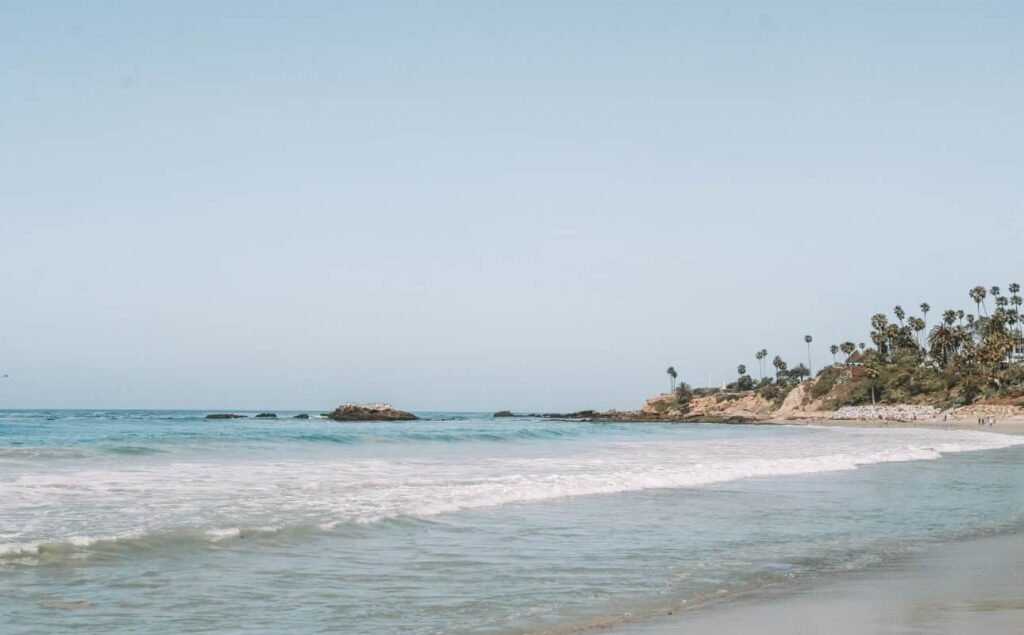
1. Pacific Coast Highway, California (West Coast Road Trip)
The Pacific Coast Highway (PCH), also known as California State Route 1, is one of the most scenic drives in the United States. Here are the details for this road trip:
Main Stops
- San Francisco: Start your journey in this iconic city, known for the Golden Gate Bridge, Alcatraz Island, and vibrant cultural scene.
- Santa Cruz: Famous for its boardwalk, beautiful beaches, and surfing culture.
- Monterey: Home to the renowned Monterey Bay Aquarium and the historic Cannery Row.
- Big Sur: A highlight of the PCH, offering breathtaking coastal views, hiking trails, and McWay Falls.
- San Simeon: Visit the famous Hearst Castle.
- Morro Bay: Known for Morro Rock and charming seaside activities.
- Pismo Beach: A classic beach town, perfect for relaxation.
- Santa Barbara: Often called the “American Riviera,” known for its Mediterranean-style architecture and beautiful beaches. It’s a great city for couples as there are many romantic activities like sunset cruises in the Santa Barbara Bay.
- Malibu: Famous for its celebrity homes and pristine beaches.
- Santa Monica: End your trip with a visit to the Santa Monica Pier and its vibrant atmosphere.
Road Trip Length
- Miles: Approximately 655 miles along the coast.
- Duration: The drive itself could take about 10-12 hours without stops. However, to fully enjoy the trip with leisurely stops and sightseeing, it’s recommended to take 5-7 days.
Best Time to Do It
- Season: The best time to drive the Pacific Coast Highway is during late spring (May and June) when the weather is pleasant and before the summer crowds. Fall (September and October) is also a great time with less fog and clear days.
Additional Tips
- The drive along the PCH is winding and should be taken slowly to enjoy the views and ensure safety.
- Accommodation should be booked in advance, especially during peak seasons.
- Be prepared for varying weather conditions, as coastal weather can be unpredictable.

2. Route 66 (Chicago to Santa Monica)
Route 66, one of the most famous highways in the United States, offers a unique journey through the heart of America. Here’s a guide for your trip:
Main Stops
- Chicago, Illinois: The starting point, known for its vibrant culture, architecture, and food scene.
- St. Louis, Missouri: See the Gateway Arch and experience the city’s rich musical heritage.
- Springfield, Missouri: Often recognized as the “Birthplace of Route 66.”
- Tulsa and Oklahoma City, Oklahoma: Explore the unique history and culture of Oklahoma.
- Amarillo, Texas: Known for the Cadillac Ranch and classic Texas culture.
- Santa Fe and Albuquerque, New Mexico: Experience the rich Native American and Spanish history.
- Flagstaff and Sedona, Arizona: Enjoy the scenic beauty of the Southwest and the red rocks of Sedona.
- Grand Canyon, Arizona: A slight detour from Route 66 but a must-see natural wonder.
- Las Vegas, Nevada: Another detour but offers an iconic American experience.
- Los Angeles and Santa Monica, California: End your journey at the Santa Monica Pier, the official end of Route 66. Take this opportunity to check off some items on your LA bucket list.
Road Trip Length
- Miles: Approximately 2,448 miles.
- Duration: To fully enjoy the trip with stops at major landmarks and attractions, plan for 2-3 weeks. The driving time alone, non-stop, is around 40-50 hours.
Best Time to Do It
- Season: The best time to travel Route 66 is from late spring (April to June) when the weather is generally mild and the summer tourist rush hasn’t begun, or early fall (September to October), to avoid the intense summer heat, especially in the desert regions.
Additional Tips
- Route 66 is not a continuous highway anymore, and parts of it have been replaced by the Interstate system. It’s important to have a good map or GPS.
- Accommodation and food options range from historic motels and diners to more modern facilities, offering a taste of Americana.
- Many small towns along the route host unique attractions and museums dedicated to the history of Route 66.

3. Overseas Highway, Florida
The Overseas Highway in Florida, also known as U.S. Highway 1, is a unique and picturesque route that takes you through the Florida Keys, providing stunning ocean views and a one-of-a-kind driving experience.
Main Stops
- Miami: Starting point, known for its vibrant culture, beaches, and art deco architecture.
- Key Largo: The first and longest key, known for snorkeling and diving opportunities, especially in John Pennekamp Coral Reef State Park.
- Islamorada: Famous for sport fishing, beautiful beaches, and the Theater of the Sea.
- Marathon: Home to the Dolphin Research Center and the Turtle Hospital, offering interactive marine animal experiences.
- Big Pine Key: Known for the National Key Deer Refuge, where you can see the endangered Key deer.
- Key West: The final stop, famous for its historical sites like Ernest Hemingway’s Home, the Southernmost Point, and vibrant Duval Street.
Road Trip Length
- Miles: Approximately 150 miles from Miami to Key West. You can also drive to Marco Island and take a ferry to Key West. This route lets you enjoy the views with a total journey time of 5 hours 30 minutes.
- Duration: The drive can technically be completed in about 4 hours, but to fully enjoy the sights and experiences, it’s recommended to take at least 2-3 days.
Best Time to Do It
- Season: The best time to drive the Overseas Highway is between March and May. During these months, the weather is comfortable, and there’s a lower risk of hurricanes. The winter months (December to February) are also popular due to the mild weather, but they can be more crowded and expensive.
Additional Tips
- The Overseas Highway is a two-lane road for much of its length, so expect some traffic and drive patiently.
- There are numerous bridges, including the famous Seven Mile Bridge, which offer spectacular views.
- Accommodations in the Keys can be quite pricey, especially during peak season, so it’s wise to book in advance.
- The Keys are known for their laid-back atmosphere, so take your time to explore the small towns and their unique charm.
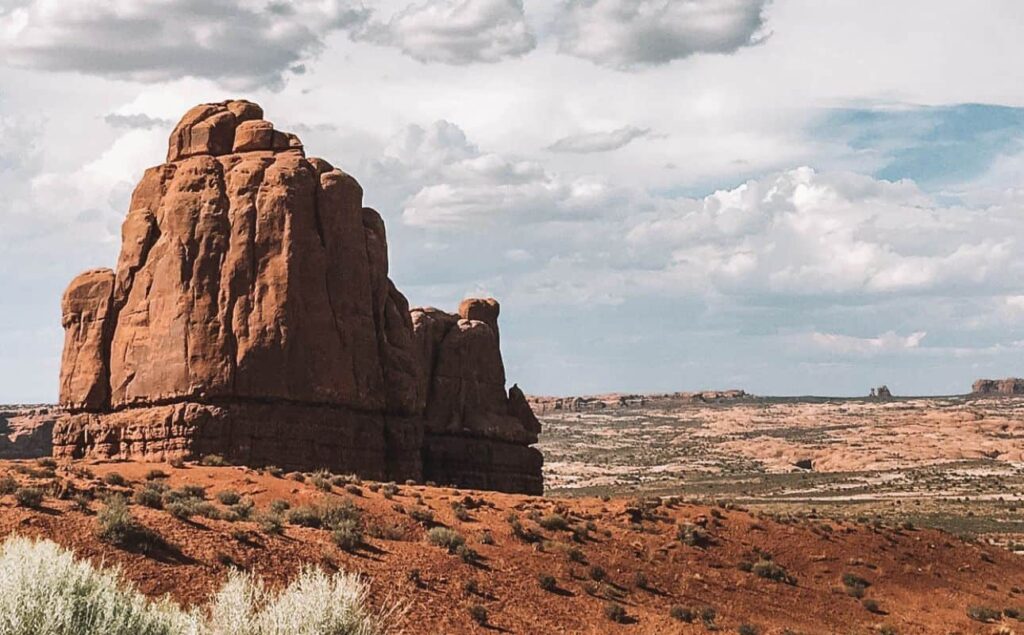
4. Arizona to Utah National Parks Road Trip
The Arizona to Utah National Parks Road Trip is a magnificent journey through some of the most breathtaking landscapes in the American Southwest. There are four routes we recommend, some even taking you Nevada and Las Vegas, making it easy to arrive in the international airport. This trip covers several iconic national parks, each offering unique and awe-inspiring natural wonders.
Main Stops
- Grand Canyon National Park, Arizona: Begin with the grandeur of the Grand Canyon, famous for its vast and colorful landscape.
- Page, Arizona: Home to Antelope Canyon and Horseshoe Bend, Page is worth to visit for a few days. You can even kayak to Antelope Canyon.
- Zion National Park, Utah: Known for its steep red cliffs, Zion Canyon Scenic Drive, and hiking trails like Angels Landing. Beware though, it’s one of the most deadly national parks in the USA.
- Bryce Canyon National Park, Utah: Famous for its unique geological structures called hoodoos, best viewed from the Bryce Amphitheater. If you can’t choose, here’s our comparison between Bryce and Grand Canyon.
- Capitol Reef National Park, Utah: Known for its colorful canyons, ridges, buttes, and monoliths.
- Arches National Park, Utah: Home to over 2,000 natural stone arches, including the famous Delicate Arch. It’s even more majestic at sunrise!
- Canyonlands National Park, Utah: Offers a diverse landscape of canyons, mesas, and buttes by the Colorado River.
Road Trip Length
- Miles: Approximately 860 miles, depending on the specific routes and detours taken.
- Duration: Ideally, allocate at least 7-10 days for this road trip to fully explore and enjoy each park.
Best Time to Do It
- Season: Spring (April to May) and fall (September to October) are the best times for this road trip. These seasons offer mild weather, making outdoor activities more enjoyable, and less crowded conditions than the peak summer months.
Additional Tips
- The weather can vary significantly between parks and even within a single day, so pack layers and be prepared for changing conditions.
- Some parks may require reservations or have limited access during peak seasons or due to park management policies, so check ahead and plan accordingly.
- National Park passes can save you money on entrance fees if you plan to visit multiple parks.
- Accommodations near popular national parks can fill up quickly, especially in peak seasons, so book your lodging well in advance.

5. The Great River Road
The Great River Road is a scenic and historic route that follows the course of the Mississippi River through ten states, from Minnesota down to Louisiana. It’s a journey that encompasses a wide array of landscapes and cultures, providing a cross-section of America’s heartland.
Main Stops
- Itasca State Park, Minnesota: The starting point, where the Mississippi River begins as a small stream flowing out of Lake Itasca.
- Twin Cities (Minneapolis-St. Paul), Minnesota: Known for their cultural landmarks and vibrant city life.
- La Crosse, Wisconsin: Offers beautiful riverfront views and a charming downtown.
- Dubuque, Iowa: Known for its historic architecture and the National Mississippi River Museum and Aquarium.
- Hannibal, Missouri: The hometown of Mark Twain, with attractions dedicated to the famous author.
- St. Louis, Missouri: The iconic Gateway Arch and numerous cultural attractions.
- Memphis, Tennessee: Famous for its influential strains of blues, soul, and rock ‘n’ roll, and attractions like Graceland.
- Vicksburg, Mississippi: Known for the Vicksburg National Military Park.
- Natchez, Mississippi: Offers well-preserved antebellum architecture.
- New Orleans, Louisiana: The final stop, famous for its vibrant music scene, distinct cuisine, and Mardi Gras festival.
Road Trip Length
- Miles: Approximately 2,000 miles along the Mississippi River.
- Duration: Ideally, plan for at least 2 weeks to truly appreciate the diverse landscapes, cities, and attractions along the way. However, the journey could be done in a shorter time frame if needed.
Best Time to Do It
- Season: The best time for this road trip is during the fall (September to November) when the weather is cooler and the fall foliage along the river is spectacular. Spring (April to June) is also a good time with pleasant weather and blooming landscapes.
Additional Tips
- The route is well marked with a pilot’s wheel logo and signs that read “Great River Road.”
- Be prepared for varying climates as you travel from north to south.
- Many river towns host festivals and events, especially during the summer and fall, which can be worth planning your trip around.
- Take time to explore the small towns along the river, each with its own unique character and history.
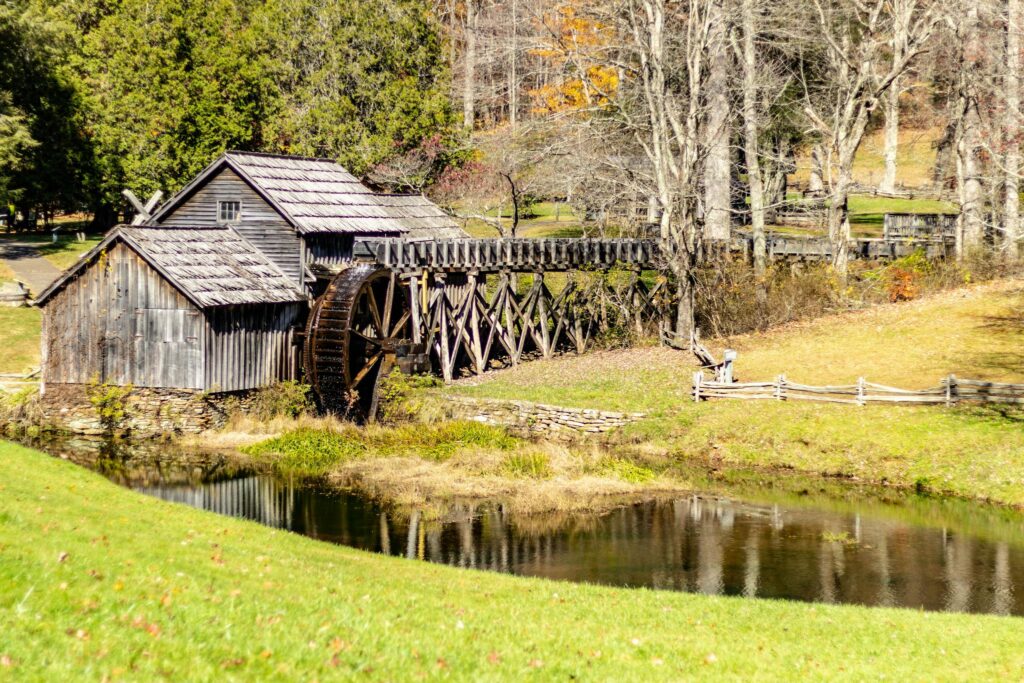
6. The Blue Ridge Parkway
The Blue Ridge Parkway is one of the most scenic drives in the United States, winding through the Appalachian Highlands of Virginia and North Carolina. It’s celebrated for its stunning natural beauty, particularly in the fall.
Main Stops
- Shenandoah National Park, Virginia: Starting point, known for its beautiful Skyline Drive and lush landscapes.
- Roanoke, Virginia: Offers cultural attractions and is a gateway to numerous hiking trails.
- Mabry Mill, Virginia: One of the parkway’s most photographed spots, especially picturesque in the fall.
- Blue Ridge Music Center, Virginia: Celebrates the music and musicians of the Blue Ridge.
- Blowing Rock and Boone, North Carolina: Charming mountain towns with access to outdoor activities.
- Linville Falls and Gorge, North Carolina: A stunning natural area with multiple waterfalls and hiking trails.
- Mount Mitchell State Park, North Carolina: Visit the highest peak east of the Mississippi.
- Asheville, North Carolina: Known for the Biltmore Estate and vibrant arts scene.
- Great Smoky Mountains National Park, North Carolina: The parkway’s southern terminus, offering diverse wildlife and ancient mountains.
Road Trip Length
- Miles: The Blue Ridge Parkway itself is 469 miles long.
- Duration: To comfortably enjoy the drive and stops, plan for 4-7 days.
Best Time to Do It
- Season: The best time to drive the Blue Ridge Parkway is during the fall (late September to October) when the foliage turns into a spectacular display of colors. Spring (May to June) is also a great time with blooming wildflowers and milder weather.
Additional Tips
- Speed limits are generally 45 mph or lower, allowing for a leisurely drive.
- The parkway does not have gas stations directly on it, so plan your fuel stops accordingly.
- Accommodations range from campgrounds to lodges and should be booked in advance, especially during peak seasons.
- Be aware of weather conditions; parts of the parkway can be closed due to fog or ice, particularly in the fall and winter.
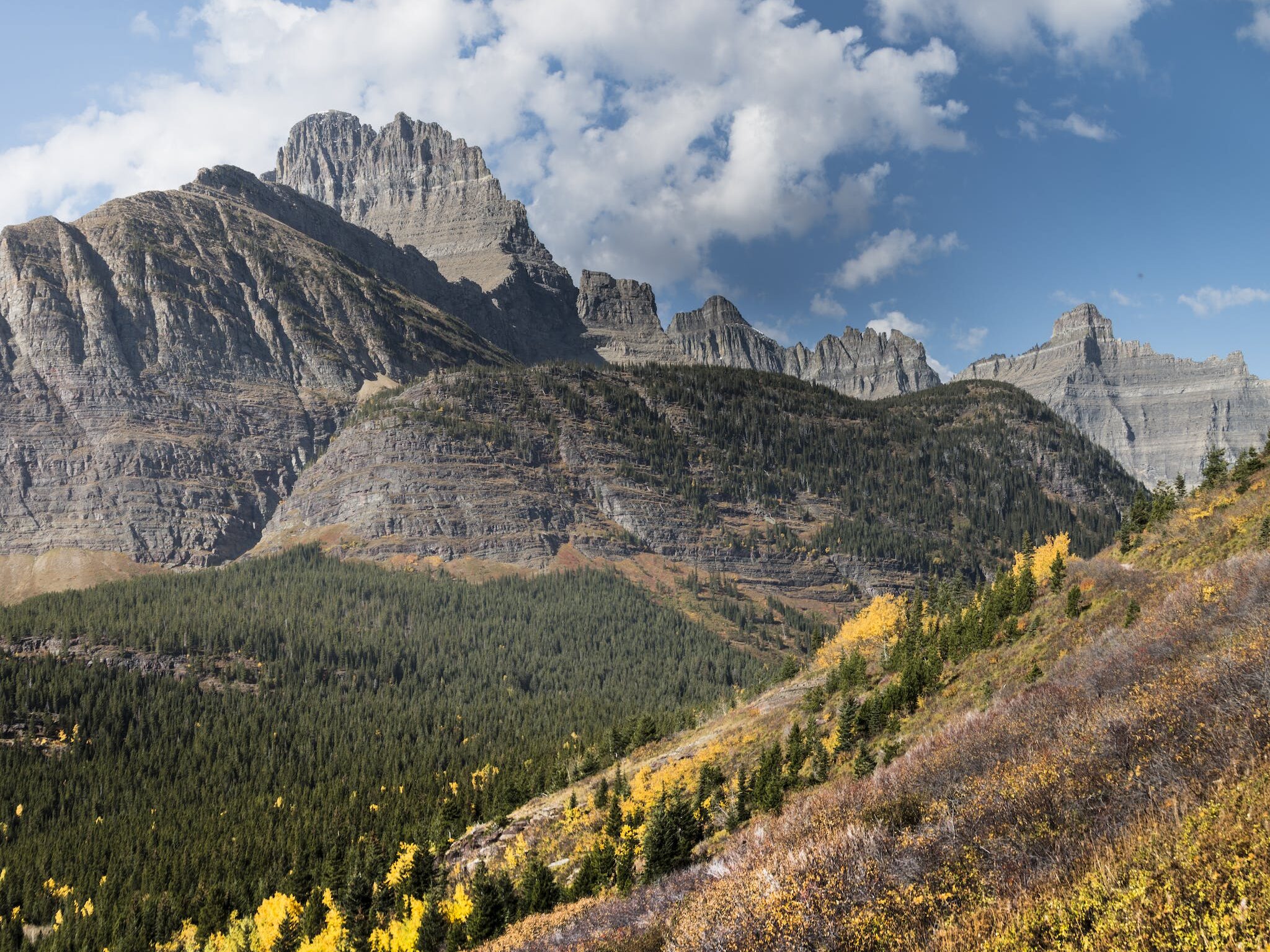
7. The Going-to-the-Sun Road in Glacier National Park
The Going-to-the-Sun Road in Glacier National Park, Montana, is a breathtaking journey through some of the most beautiful alpine scenery in the United States. This road trip offers a unique opportunity to experience the rugged beauty of the Rocky Mountains.
Main Stops
- West Glacier (Apgar Visitor Center): The western entrance to the park and a good starting point for your journey.
- Lake McDonald: The largest lake in Glacier National Park, known for its crystal-clear waters and picturesque setting.
- Logan Pass: The highest point on the road, offering panoramic views of the park and access to hiking trails like the Hidden Lake Trail and the Highline Trail.
- St. Mary Lake: The second largest lake in the park, known for its vivid blue waters and the backdrop of Wild Goose Island.
- Many Glacier: An area on the east side of the park, known for its impressive landscapes and abundant wildlife.
Road Trip Length
- Miles: The Going-to-the-Sun Road is about 50 miles long.
- Duration: The drive itself can be done in about 2 hours, but to fully enjoy and explore, plan to spend at least a full day. If you’re planning to do hiking or sightseeing, consider extending your stay to 2-3 days.
Best Time to Do It
- Season: The best time to drive the Going-to-the-Sun Road is during the summer months (late June to early September) when the entire road is typically open, and the weather is more favorable for sightseeing and hiking. Keep in mind the road can be closed due to snow even in early summer or fall.
Additional Tips
- The road is narrow and winding, with steep drop-offs in places, so drive cautiously.
- Parking at popular spots like Logan Pass can fill up quickly, especially in July and August, so start early in the day.
- Be prepared for rapidly changing weather conditions, even in summer.
- Check the park’s website for road status and any travel restrictions or requirements before your trip.
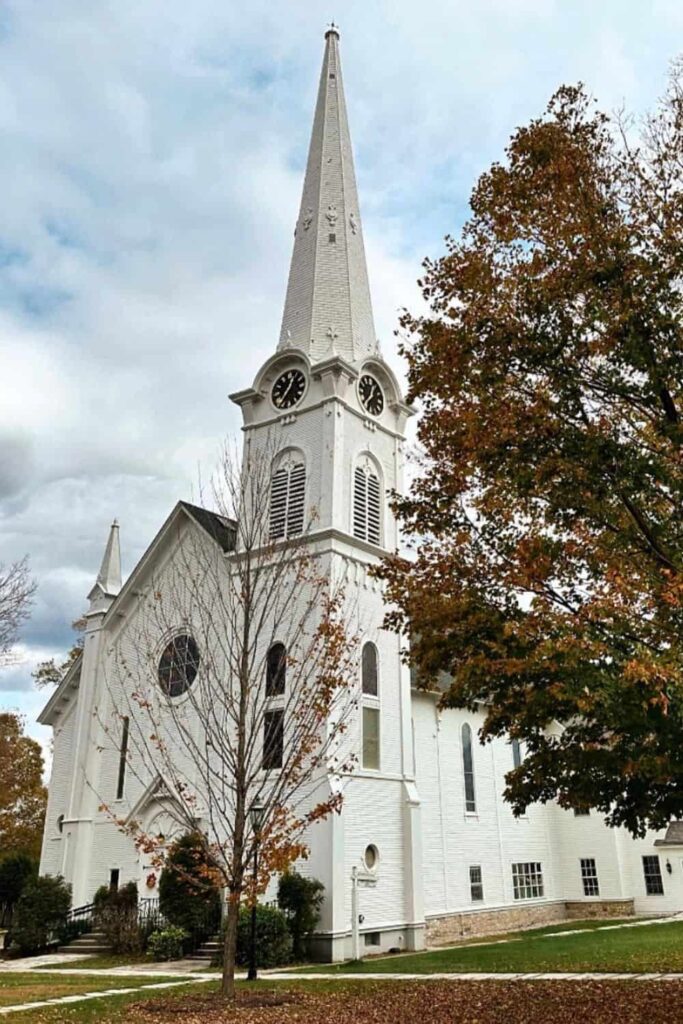
8. The New England Fall Foliage Tour
The New England Fall Foliage Tour through Vermont, New Hampshire, and Maine is a captivating journey that showcases the spectacular autumn colors of the northeastern United States. This trip takes you through charming small towns, scenic byways, and stunning natural landscapes.
Main Stops
- Stowe, Vermont: Known for its beautiful mountain scenery and as a starting point for exploring the Vermont fall colors, it’s one of the best towns to visit during fall.
- Woodstock, Vermont: A quintessential Vermont town with covered bridges and picturesque streets.
- White Mountain National Forest, New Hampshire: Offers some of the most spectacular fall foliage in the region.
- Conway Scenic Railroad, New Hampshire: A unique way to view the foliage through a historic rail journey.
- Acadia National Park, Maine: Provides stunning coastal foliage views and beautiful landscapes.
- Portland, Maine: A charming coastal city with a vibrant food scene and historic lighthouses.
Road Trip Length
- Miles: The trip can vary, but a comprehensive tour covering the main spots could be around 400-500 miles.
- Duration: Ideally, plan for 7-10 days to fully enjoy the scenery and stops. The driving time will depend on the specific routes taken and time spent at each stop.
Best Time to Do It
- Season: The peak time for fall foliage in New England is typically from late September to mid-October. This can vary slightly depending on weather conditions and the specific area.
Additional Tips
- The fall foliage season attracts many tourists, so it’s advisable to book accommodations well in advance.
- Be prepared for a range of weather conditions, as autumn can be quite variable in New England.
- Consider taking some of the scenic byways for more spectacular views, like the Kancamagus Highway in New Hampshire.
- Local harvest festivals and apple picking are popular activities during this season and can be a delightful addition to your trip.
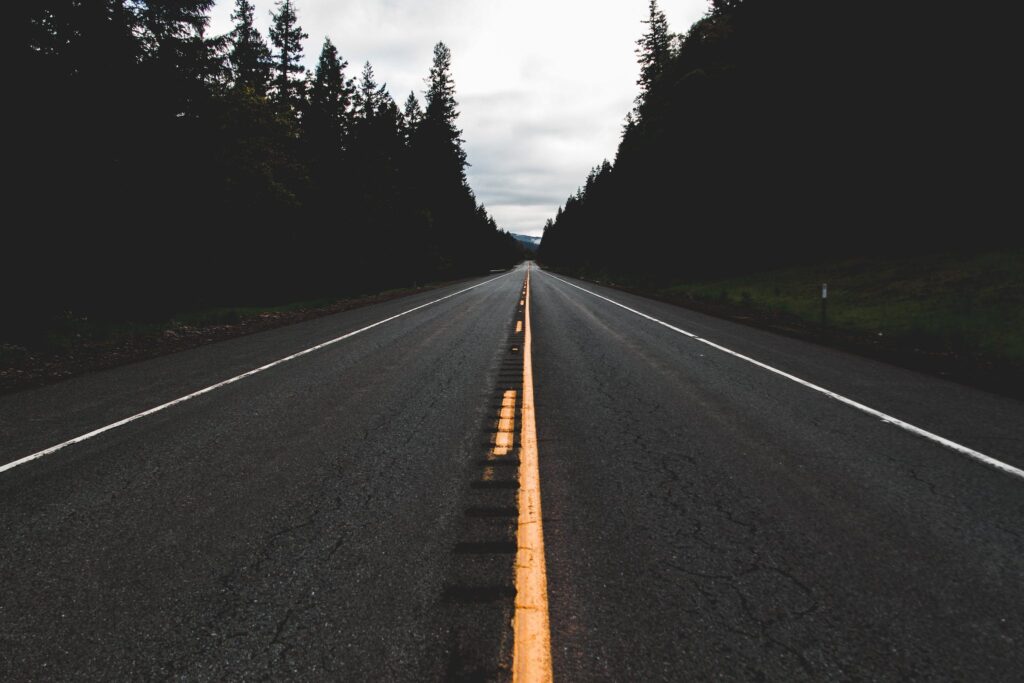
9. The Oregon Coast Highway 101
The Oregon Coast Highway 101 road trip is a stunning journey along the Pacific Northwest coast, offering breathtaking views, charming coastal towns, and numerous natural attractions.
Main Stops
- Astoria: The northernmost city on the Oregon coast, known for its historical significance and the Astoria Column.
- Cannon Beach: Famous for its picturesque Haystack Rock and beautiful sandy beaches.
- Tillamook: Home to the Tillamook Cheese Factory, where visitors can tour and taste local cheese.
- Newport: Known for the Oregon Coast Aquarium and the historic Yaquina Head Lighthouse.
- Florence: Famous for the nearby Oregon Dunes National Recreation Area.
- Coos Bay: The largest city on the Oregon Coast, known for its outdoor activities and beautiful parks.
- Bandon: Renowned for its stunning rock formations at Bandon Beach.
- Port Orford: The oldest town on the Oregon coast, offering spectacular ocean views.
- Gold Beach: Known for the Rogue River and its outdoor adventure opportunities.
- Brookings: The southernmost city on the Oregon Coast, close to the California border, known for its mild climate and beautiful azalea gardens.
Road Trip Length
- Miles: Highway 101 along the Oregon Coast stretches approximately 363 miles.
- Duration: The drive alone can take around 9-10 hours without stops. However, to fully experience the coast and its attractions, plan for at least 4-7 days.
Best Time to Do It
- Season: The best time for this road trip is during the summer months (June to August) when the weather is generally warmer and drier, making it ideal for beach activities and sightseeing. However, the coast is beautiful year-round, and each season offers its own unique charm.
Additional Tips
- Be prepared for variable weather, as the Oregon Coast can be foggy and cool, even in the summer.
- The Oregon Coast is known for its seafood, so don’t miss out on the local cuisine.
- Check tide tables if you’re interested in tide pooling or visiting certain beaches at low tide.
- Many towns along the coast host festivals and events during the summer, which can be a fun addition to your trip.
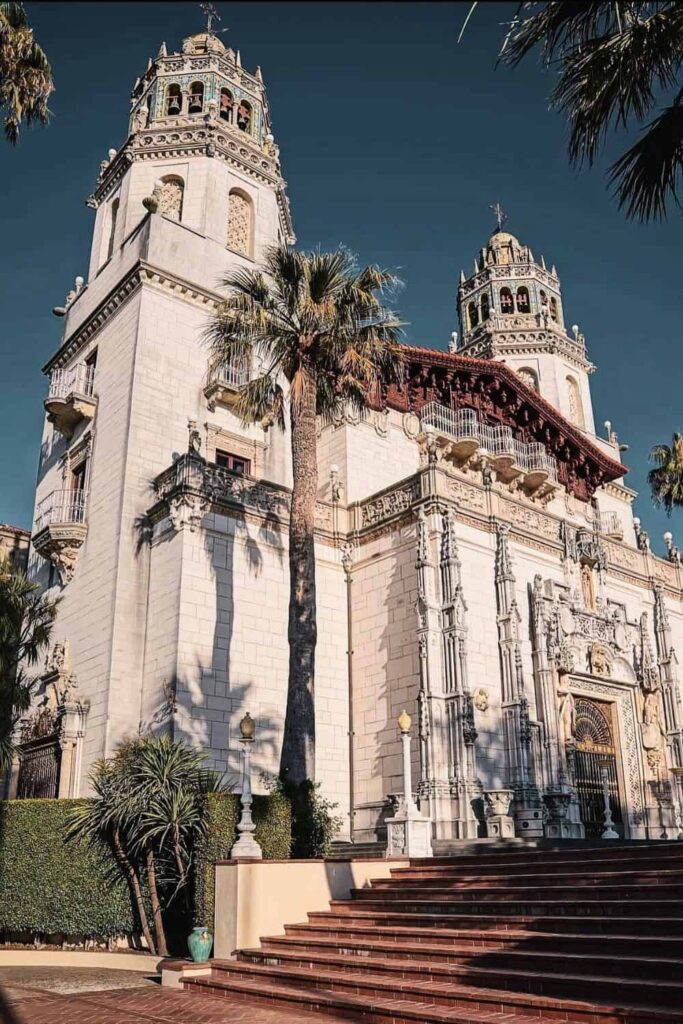
10. The Big Sur Coast Highway
The Big Sur Coast Highway, officially part of California’s Highway 1, is a world-renowned scenic drive that offers dramatic ocean views, towering cliffs, and the majesty of redwood forests. It’s a quintessential California experience, combining natural beauty with iconic landmarks.
Main Stops
- Carmel-by-the-Sea: A charming town known for its artistic community, picturesque streets, and beautiful beach.
- Point Lobos State Natural Reserve: Offers excellent opportunities for hiking, wildlife viewing, and photography.
- Bixby Creek Bridge: One of the most photographed bridges in California, offering stunning views of the coastline.
- Pfeiffer Big Sur State Park: Explore the redwood forests and enjoy the park’s natural beauty.
- McWay Falls (Julia Pfeiffer Burns State Park): A famous 80-foot waterfall that drops into the ocean, viewable from a short trail.
- Nepenthe: A restaurant offering breathtaking views of the coast, perfect for a meal or a quick stop.
- Ragged Point: Known as the “Gateway to Big Sur,” offering some of the best views of the rugged coastline.
- Hearst Castle (San Simeon): Slightly off the Big Sur route but worth the detour, this historic estate is a National Historic Landmark and one of the fairytale castles in the USA.
Road Trip Length
- Miles: The Big Sur stretch of Highway 1 is about 90 miles long.
- Duration: The drive itself can be done in a few hours, but to truly appreciate the area, plan for at least 1-2 days. This allows time for stops, short hikes, and enjoying the views.
Best Time to Do It
- Season: The best time to drive the Big Sur Coast Highway is during the spring (April to May) and fall (September to October). These periods usually offer clear weather and smaller crowds. Summer can be beautiful but often crowded, and winter brings the risk of heavy rains and road closures.
Additional Tips
- Cell service can be spotty along the route, so plan accordingly.
- Accommodations in Big Sur range from campgrounds to luxury hotels, and it’s advisable to book in advance, especially during peak seasons.
- Be prepared for changing weather conditions, and always check road conditions before your trip as portions of Highway 1 can close due to landslides or maintenance.
- Many overlooks and trailheads have limited parking, so it’s best to start your journey early in the day to find parking and avoid crowds.

11. The Texas Hill Country road trip
The Texas Hill Country road trip is a delightful journey through the heart of Texas, characterized by rolling hills, fields of wildflowers, and charming small towns. This region combines natural beauty with rich history and culture.
Main Stops
- Fredericksburg: Known for its German heritage, wineries, and the National Museum of the Pacific War.
- Enchanted Rock State Natural Area: Offers hiking and great views from the massive pink granite dome.
- Johnson City: The hometown of President Lyndon B. Johnson and the location of his boyhood home.
- LBJ Ranch and National Historical Park: Explore the ranch and learn about the life of the 36th President.
- Austin: The state capital, known for its live music scene, vibrant cultural life, and outdoor activities.
- San Antonio: Famous for the Alamo, River Walk, and rich Spanish heritage.
- Bandera: Known as the “Cowboy Capital of the World,” offering a glimpse into Texas’s ranching history.
- Luckenbach: A tiny, iconic town known for its historic dance hall and live country music.
- Wimberley: A quaint hill country town with shops, art galleries, and natural swimming holes like Jacob’s Well.
- Boerne: Offers a charming main street with antique shops and historic buildings.
Road Trip Length
- Miles: The distance will vary depending on the specific route and stops, but a comprehensive tour of the Hill Country could be around 300-400 miles.
- Duration: To thoroughly enjoy the region, plan for at least 3-5 days, though you could easily spend longer exploring the various towns and natural attractions.
Best Time to Do It
- Season: Spring (March to May) is the best time to visit, especially to see the wildflowers, including the famous Texas bluebonnets, in full bloom. Fall (September to November) is also a great time with milder weather and fall foliage.
Additional Tips
- The Hill Country is known for its wineries, so consider visiting a few for wine tastings.
- If you’re interested in swimming or water activities, summer can be a great time to enjoy the region’s rivers and lakes.
- Be sure to check the calendar for local events and festivals, which are frequent in this region and offer a taste of local culture and hospitality.
- Roads in the Hill Country can be narrow and winding, so drive carefully and enjoy the scenic views.
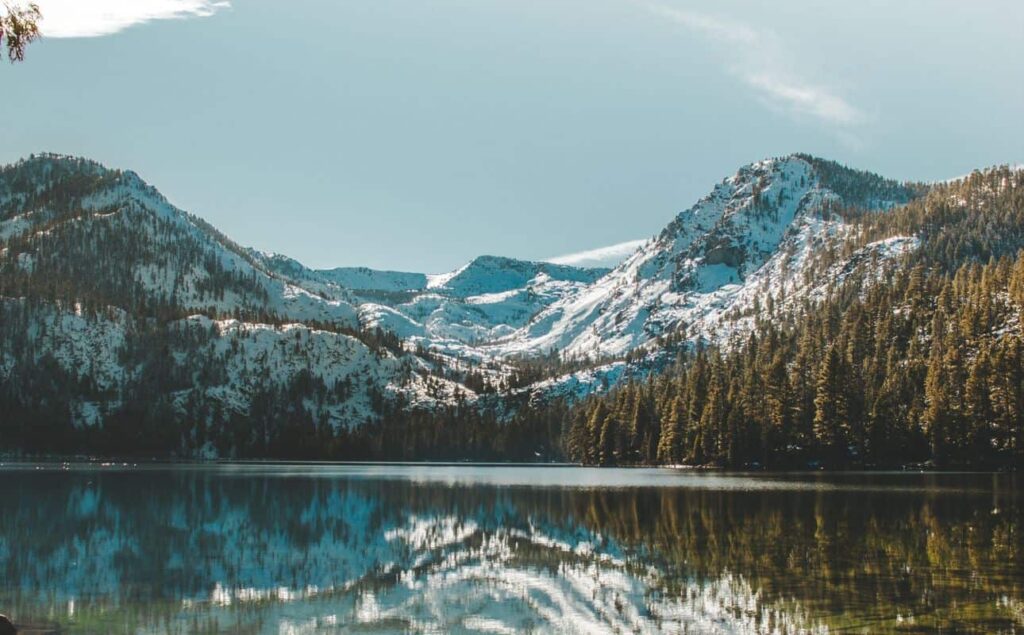
12. The Loneliest Road
The Loneliest Road, also known as U.S. Route 50 in Nevada, is a unique and starkly beautiful journey through some of the most remote and unspoiled areas of the American West. It’s a trip that offers solitude, expansive desert landscapes, and a taste of Nevada’s small-town life.
Main Stops
- Lake Tahoe: Start your journey near this stunning alpine lake on the border of California and Nevada.
- Carson City: Nevada’s state capital, with historical attractions and museums.
- Fallon: Known for the Naval Air Station Fallon and the surrounding agricultural community.
- Sand Mountain: A large sand dune and popular spot for off-road enthusiasts.
- Austin: A historic small town with charming 19th-century architecture and nearby Stokes Castle.
- Eureka: Often called “The Friendliest Town on the Loneliest Road,” known for its well-preserved historical buildings.
- Ely: Home to the Nevada Northern Railway Museum and the nearby Great Basin National Park.
- Great Basin National Park: Explore the Lehman Caves and hike Mount Wheeler.
Road Trip Length
- Miles: Approximately 320 miles across Nevada on U.S. Route 50.
- Duration: While the drive can be done in a day, to fully appreciate the landscapes and small towns, plan for 2-3 days.
Best Time to Do It
- Season: The best time to travel the Loneliest Road is during the spring (April to June) or fall (September to October) when the weather is more temperate. Summers can be extremely hot in the desert, and winters can see harsh conditions and snow, especially in higher elevations.
Additional Tips
- Services (gas, food, lodging) are few and far between, so plan accordingly and make sure your vehicle is in good condition.
- The route offers a chance to see some of Nevada’s historical “boom and bust” towns, which flourished during mining booms.
- Be prepared for long stretches of road without cell service.
- If you’re interested in stargazing, the dark skies in this remote area offer some of the best opportunities in the U.S.
13. Skyline Drive in Shenandoah National Park
Skyline Drive in Shenandoah National Park, Virginia, is a stunning mountain drive renowned for its scenic vistas, wildlife viewing opportunities, and, particularly, its spectacular display of autumn foliage.
Main Stops
- Front Royal: The northern entrance to Skyline Drive, offering access to the park and nearby wineries.
- Dickey Ridge Visitor Center: A good first stop for information and a short walk to a viewpoint.
- Skyland: Located at the highest point on Skyline Drive, it offers lodging, dining, and spectacular views.
- Big Meadows: A large, open area that’s great for wildlife spotting, hiking, and has a visitor center.
- Dark Hollow Falls: One of the most popular short hikes in the park leading to a beautiful waterfall.
- Loft Mountain: Another area with great views, camping facilities, and hiking trails.
- Rockfish Gap: The southern end of Skyline Drive, where it meets the Blue Ridge Parkway.
Road Trip Length
- Miles: Skyline Drive runs for 105 miles along the crest of the Blue Ridge Mountains.
- Duration: The drive can technically be completed in about 3 hours, but it’s best enjoyed over 1-2 days to allow time for stops, short hikes, and to take in the views.
Best Time to Do It
- Season: The best time to drive Skyline Drive is in the autumn (October to early November) when the fall foliage is at its peak, painting the landscape in vibrant colors. Spring is also beautiful with blooming wildflowers and fresh greenery.
Additional Tips
- The speed limit is 35 mph and lower in some sections, allowing for a leisurely drive and wildlife viewing.
- Be aware of wildlife, especially deer, on and near the road.
- The park charges an entrance fee, but the pass is valid for seven consecutive days.
- Weekends in October can be very busy due to the popularity of the fall colors, so consider a weekday visit if possible.
- Several overlooks provide stunning views of the Shenandoah Valley and the Virginia Piedmont, so make frequent stops to enjoy them.
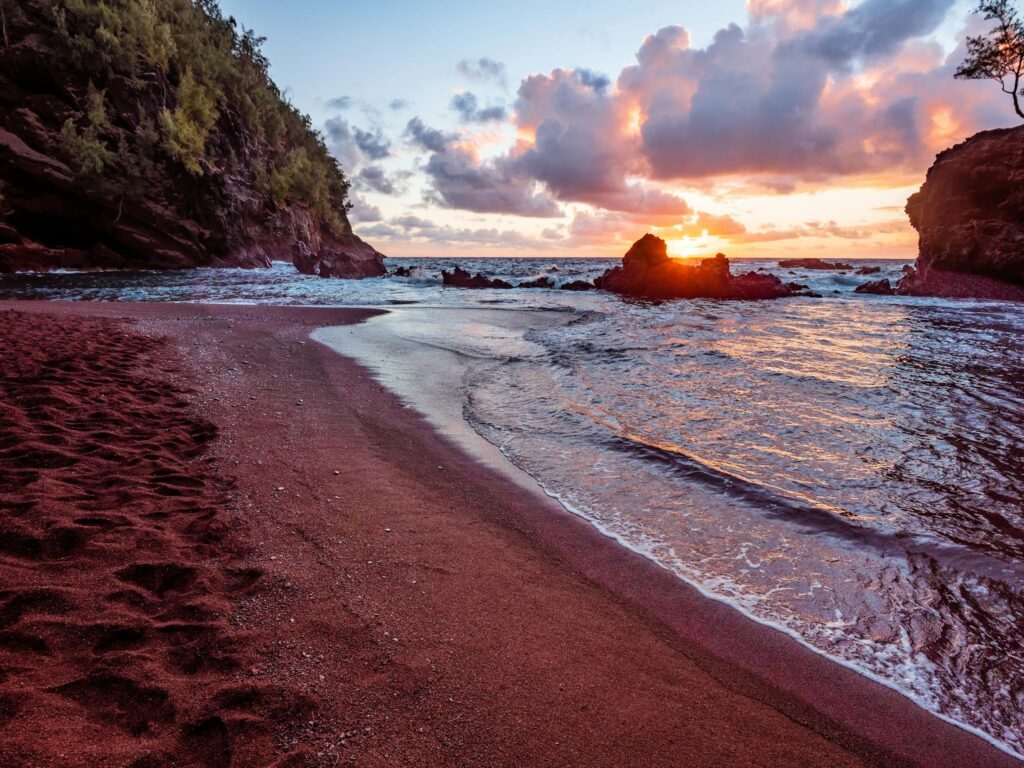
14. Hana Highway, Maui, Hawaii
The Hana Highway in Maui, Hawaii, is a spectacular coastal drive known for its lush landscapes, stunning ocean views, numerous waterfalls, and the immersive experience of traveling through a tropical rainforest.
Main Stops
- Paia Town: A charming, small town which is the last stop for gas and provisions before the journey to Hana.
- Ho’okipa Lookout: Offers great views of surfers and sea turtles, depending on the time of year.
- Twin Falls: One of the first waterfall stops on the road where you can take a short hike to view or swim.
- Garden of Eden Arboretum: A botanical garden with beautiful trails and scenic views.
- Ke’anae Peninsula: Known for its stunning ocean views and taro fields.
- Wai’anapanapa State Park: Famous for its black sand beach, sea caves, and natural stone arch.
- Hana Town: A small, remote town that provides a look at traditional Hawaiian culture.
- Hamoa Beach: One of Maui’s most beautiful beaches, just past Hana town.
- Seven Sacred Pools at Ohe’o (Pipiwai Trail): A part of Haleakala National Park, known for its beautiful pools and waterfalls.
Road Trip Length
- Miles: The Hana Highway (Highway 36 and 360) stretches about 52 miles from Kahului to Hana.
- Duration: The drive can take anywhere from 2 to 4 hours one-way without stops. However, to truly enjoy the experience, plan for a full day trip or even consider staying overnight in Hana.
Best Time to Do It
- Season: The road to Hana can be enjoyed year-round, but the best weather is typically from April to October. It’s worth noting that rain is common in this area, as it’s a rainforest, but it often leads to more spectacular waterfalls.
Additional Tips
- The road is narrow and winding with over 600 curves and 59 bridges, many of which are one-lane, so drive cautiously.
- Start your journey early in the morning to avoid traffic and allow enough time for stops.
- Bring food and water with you, as there are limited places to buy provisions along the way.
- Respect private property and stay safe by not trespassing or taking unnecessary risks, especially at waterfalls and when hiking.
- Cellular reception is limited, so download maps or directions in advance.
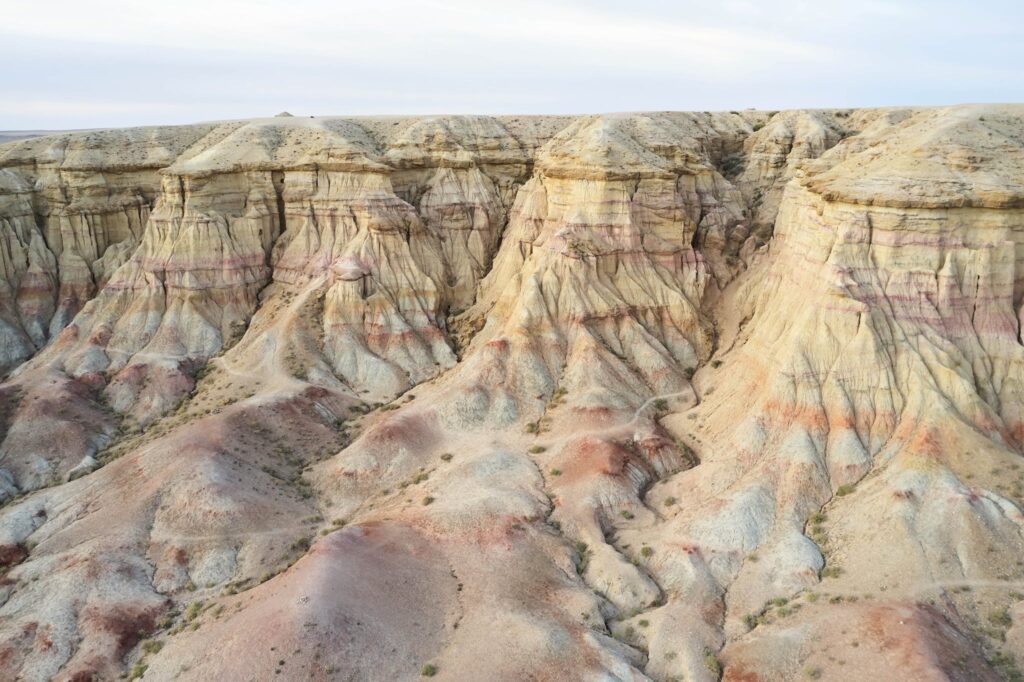
15. The Black Hills and Badlands, South Dakota
The road trip through the Black Hills and Badlands of South Dakota is an extraordinary journey, offering a mix of stunning natural landscapes, rich history, and iconic American monuments.
Main Stops
- Badlands National Park: Start with the striking landscapes of the Badlands, known for their layered rock formations, steep canyons, and towering spires.
- Wall Drug Store in Wall, SD: A famous tourist attraction known for its unique shopping experience and free ice water.
- Minuteman Missile National Historic Site: Learn about the Cold War history and see a preserved underground missile silo.
- Rapid City: Known as the “Gateway to the Black Hills” and famous for its dinosaur statues and the City of Presidents sculpture project.
- Mount Rushmore National Memorial: See the iconic sculpture of Presidents Washington, Jefferson, Roosevelt, and Lincoln.
- Crazy Horse Memorial: A monument being carved into the Black Hills to honor the Native American warrior, Crazy Horse.
- Custer State Park: Known for its wildlife, scenic drives (like the Wildlife Loop Road), and beautiful landscapes.
- Wind Cave National Park: One of the longest and most complex caves in the world.
- Deadwood: A historic town known for its gold rush history and as the final resting place of Wild Bill Hickok.
Road Trip Length
- Miles: The trip can vary in length but generally covers about 250-300 miles, depending on the specific routes and detours taken.
- Duration: To comfortably enjoy the major attractions, plan for at least 3-5 days.
Best Time to Do It
- Season: The best time to visit the Black Hills and Badlands is from late spring to early fall (May to September), when the weather is most favorable for outdoor activities. Summer is peak tourist season, so expect more crowds, especially at major attractions like Mount Rushmore.
Additional Tips
- The Black Hills region offers numerous hiking and biking trails for outdoor enthusiasts.
- Wildlife is abundant in Custer State Park, so keep an eye out for bison, pronghorns, and other wildlife.
- Be prepared for varying weather conditions, as the weather can change rapidly in the mountains and plains.
- Some attractions may have entrance fees or require reservations, especially during peak tourist season.
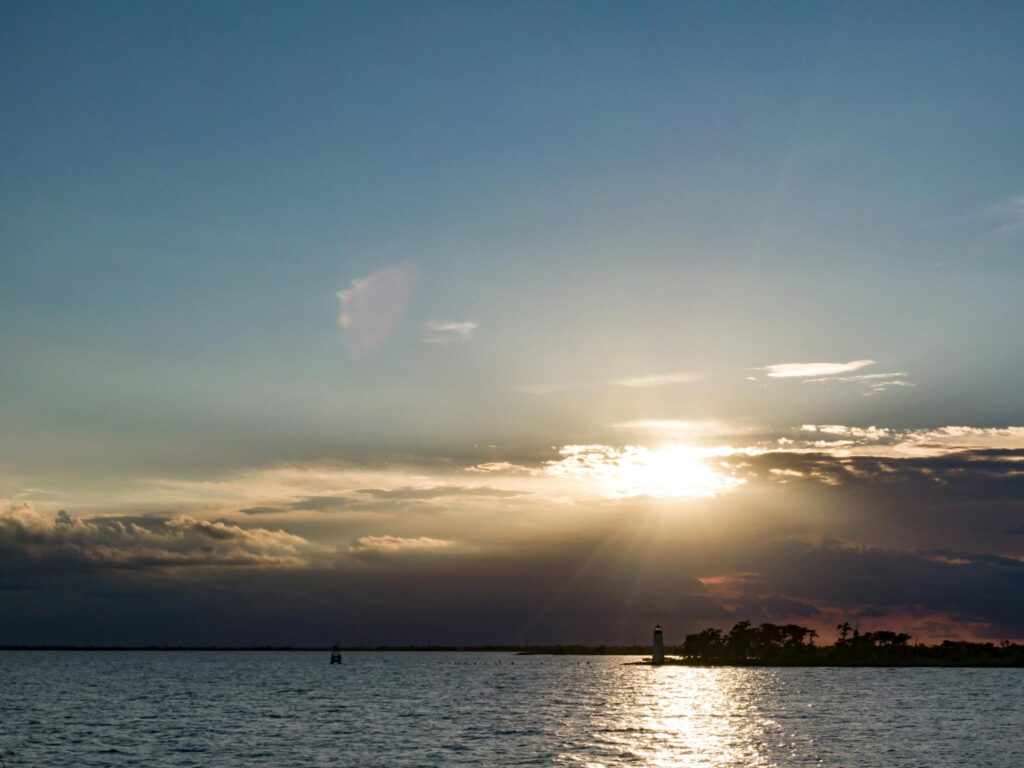
16. Natchez Trace Parkway
The Natchez Trace Parkway is a historic and scenic route that spans from Natchez, Mississippi, to Nashville, Tennessee. This drive takes you through a region rich in Native American history, early American history, and stunning natural beauty.
Main Stops
- Natchez, Mississippi: Starting point, known for its antebellum homes and historical significance.
- Emerald Mound: One of the largest ceremonial mounds built by the Mississippian culture, around 1400 A.D.
- Windsor Ruins: The haunting remains of a large antebellum plantation.
- Vicksburg, Mississippi: Visit the Vicksburg National Military Park, a significant Civil War battle site.
- Cypress Swamp, Mississippi: A short walk leads you through a beautiful cypress swamp.
- Tupelo, Mississippi: The birthplace of Elvis Presley and home to the Tupelo Automobile Museum.
- Shiloh National Military Park, Tennessee: Another important Civil War battlefield.
- Fall Hollow Waterfall: A beautiful spot where a short trail leads to a waterfall.
- Leiper’s Fork, Tennessee: A charming historic village with shops and restaurants.
- Nashville, Tennessee: The endpoint, known as the “Music City” and famous for its country music heritage.
Road Trip Length
- Miles: The parkway is approximately 444 miles long.
- Duration: To fully enjoy the drive and stops, plan for at least 3-5 days. This allows time to explore the historical sites, natural areas, and small towns along the route.
Best Time to Do It
- Season: Spring (April to May) and fall (October to November) are ideal times to travel the Natchez Trace Parkway. These seasons offer pleasant weather and the beauty of spring wildflowers or fall foliage.
Additional Tips
- The speed limit on the parkway is generally 50 mph, allowing for a leisurely and scenic drive.
- There are no commercial vehicles allowed on the parkway, which helps maintain a peaceful driving experience.
- Accommodations along the parkway include campgrounds and nearby hotels in the small towns and cities.
- Fuel stations are not available on the parkway itself, so plan your gas stops in the towns along the way.

17. Florida Panhandle to Key West
The road trip from the Florida Panhandle to Key West takes you through a diverse array of Floridian landscapes and cultures, from the tranquil beaches of the Panhandle to the bustling streets of Miami and the laid-back ambiance of the Florida Keys.
Main Stops
- Pensacola: Start in the western part of the Panhandle, known for its white sandy beaches and the Naval Aviation Museum.
- Destin: Famous for its emerald waters and excellent fishing opportunities.
- Apalachicola: A charming old Florida town known for its oysters and historic buildings.
- Tallahassee: Florida’s capital city, offering a blend of history, culture, and natural beauty.
- Gainesville: Home to the University of Florida and the natural springs of nearby state parks.
- Orlando: Famous for its theme parks, including Walt Disney World and Universal Studios.
- West Palm Beach: Known for its upscale shops and vibrant nightlife.
- Miami: A bustling metropolis known for its beaches, art deco architecture, and diverse cultural influences.
- Florida Keys: A string of tropical islands stretching about 120 miles off the state’s southern tip, ending in Key West.
- Key West: The final stop, famous for its relaxed atmosphere, historic sites like Ernest Hemingway’s home, and beautiful sunsets at Mallory Square.
Road Trip Length
- Miles: Approximately 800 miles from Pensacola to Key West.
- Duration: To comfortably enjoy the trip, plan for at least 7-10 days, allowing time to explore each major stop and enjoy the beaches and attractions.
Best Time to Do It
- Season: The best time to embark on this road trip is either in the spring (March to May) when the weather is warm but not yet hot and humid, or in the fall (September to November) when the summer crowds have diminished.
Additional Tips
- Be prepared for traffic in the larger cities, especially Miami.
- The Florida Keys are connected by the Overseas Highway, which offers stunning ocean views but can get busy, especially on weekends and holidays.
- Accommodations range from beach resorts to quaint bed and breakfasts, so book in advance, especially in the Keys.
- This trip offers a chance to experience a wide range of Florida’s ecosystems, from springs and swamps to coral reefs, so consider packing for various activities like snorkeling, hiking, and beach lounging.

18. The Road to Nowhere
The Road to Nowhere, known as the Dalton Highway in Alaska, offers a journey into some of the most remote and untouched landscapes in North America. This rugged and challenging drive is a true adventure into the Alaskan wilderness.
Main Stops
- Fairbanks: The starting point of the journey, offering all necessary supplies and last-minute preparations.
- Yukon River Camp: The first major stop, near the mighty Yukon River with a bridge offering stunning views.
- Arctic Circle: A significant milestone, with a sign marking your crossing into the Arctic.
- Coldfoot: Once a mining camp, now a key stop for fuel and basic services.
- Wiseman: A small, historic mining community offering a glimpse into Alaska’s past.
- Brooks Range: Pass through the stunning Atigun Pass in the Brooks Range, offering dramatic mountain scenery.
- Prudhoe Bay/Deadhorse: The end of the road, near the oil fields of Prudhoe Bay on the Arctic Ocean.
Road Trip Length
- Miles: The Dalton Highway stretches about 414 miles from Fairbanks to Deadhorse.
- Duration: Due to the challenging nature of the road and the remote areas it passes through, plan for at least 3-4 days for the journey.
Best Time to Do It
- Season: The best time for this trip is during the short summer season (June to early September). During these months, the road conditions are more manageable, and the weather is milder.
Additional Tips
- The Dalton Highway is mostly gravel, with very few services and amenities, so be fully prepared with supplies, extra fuel, and emergency kits.
- The road can be very challenging, with steep grades, sharp curves, and often poor visibility due to weather conditions or truck traffic.
- Be prepared for the presence of large trucks, as the highway is a supply route for the oil fields at Prudhoe Bay.
- Wildlife sightings are common, so be alert for animals on or near the roadway.
- Cell service is almost non-existent, so a satellite phone is advisable for emergencies.
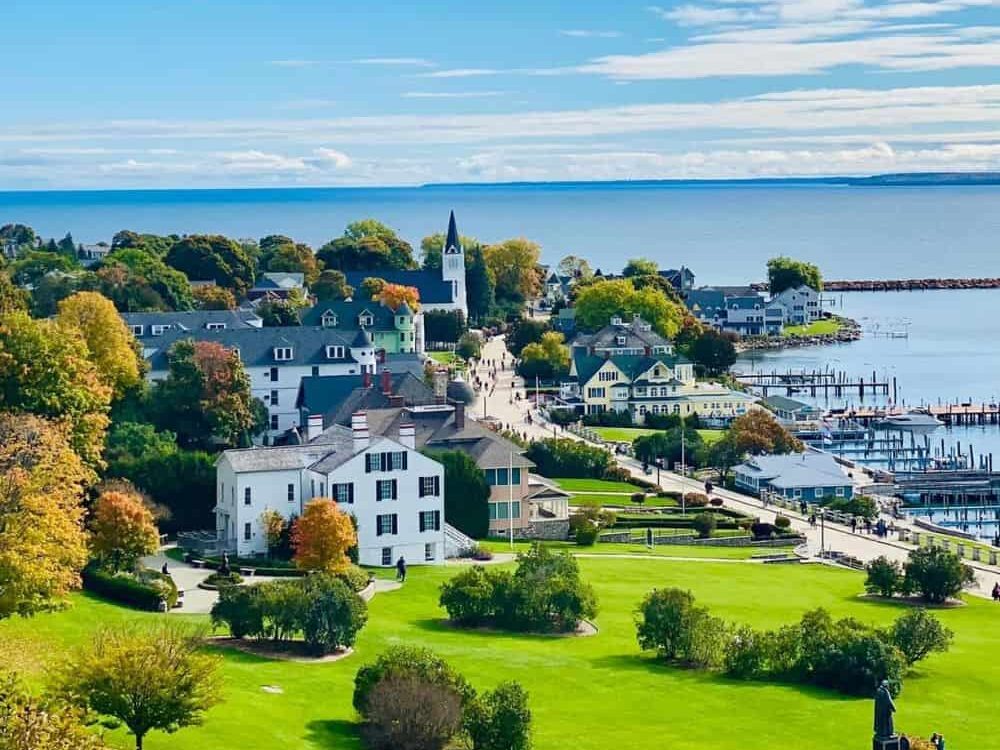
19. Michigan’s Upper Peninsula
A road trip through Michigan’s Upper Peninsula (U.P.) is a journey into the heart of the Great Lakes region, characterized by vast forests, stunning lake shores, and charming small towns. This area offers a blend of natural beauty, history, and outdoor adventures.
Main Stops
- Mackinac Island: Accessible by ferry, known for its car-free streets, historic sites, and fudge shops.
- Sault Ste. Marie: Home to the famous Soo Locks, where you can watch ships pass between Lake Superior and Lake Huron.
- Pictured Rocks National Lakeshore: Known for its colorful sandstone cliffs, beaches, and hiking trails.
- Tahquamenon Falls State Park: Famous for its large waterfall and beautiful hiking trails.
- Marquette: The largest city in the U.P., offering a mix of culture, history, and outdoor activities, along with beautiful views of Lake Superior.
- Keweenaw Peninsula: Rich in copper mining history and home to the Keweenaw National Historical Park.
- Porcupine Mountains Wilderness State Park: Known for its old-growth forest, waterfalls, and scenic overlooks of Lake Superior.
- Munising: A gateway to outdoor adventures, including waterfalls, lakeshore caves, and boat tours.
Road Trip Length
- Miles: The U.P. stretches approximately 320 miles from east to west. The total distance of the trip depends on the specific route but expect around 400-500 miles to cover the main attractions.
- Duration: Plan for at least 5-7 days to enjoy the region’s natural beauty and attractions without rushing.
Best Time to Do It
- Season: Summer (June to August) is the most popular time to visit, offering warm weather and full access to all parks and attractions. Fall (September to October) is also beautiful, especially for viewing the autumn foliage.
Additional Tips
- The U.P. is known for its outdoor activities, including hiking, fishing, kayaking, and in the winter, snowmobiling and skiing.
- Weather can be unpredictable, especially near Lake Superior, so pack accordingly.
- Many attractions are in rural areas with limited cell service, so plan your route and stops ahead of time.
- The region’s small towns offer unique local shops, restaurants, and a chance to experience the local culture and hospitality.
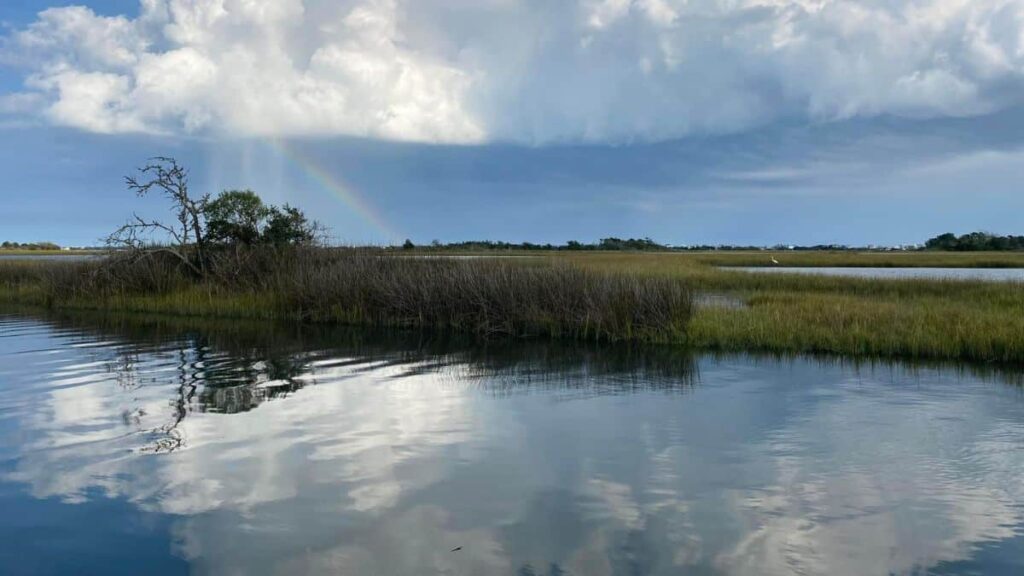
20. The Outer Banks, North Carolina
The Outer Banks of North Carolina offer a distinctive coastal road trip experience along a series of narrow barrier islands. Renowned for their natural beauty, historical sites, and charming seaside towns, the Outer Banks provide a blend of relaxation and adventure.
Main Stops
- Corolla: Known for its wild horses and the historic Currituck Beach Lighthouse.
- Duck: A quaint town with a charming boardwalk, shops, and water sports opportunities.
- Kitty Hawk: Famous for the Wright Brothers National Memorial, where the first powered flight took place.
- Kill Devil Hills: Offers beautiful beaches and the Wright Brothers National Memorial Visitor Center.
- Nags Head: Known for Jockey’s Ridge State Park, home to the East Coast’s tallest sand dune.
- Roanoke Island: Site of the Lost Colony and the Roanoke Island Festival Park, which offers historical attractions.
- Cape Hatteras National Seashore: Offers beautiful beaches, the iconic Cape Hatteras Lighthouse, and opportunities for fishing and surfing.
- Ocracoke Island: Accessible by ferry, known for its secluded beaches, Ocracoke Lighthouse, and laid-back atmosphere.
- Hatteras Island: Home to several charming villages, pristine beaches, and the Graveyard of the Atlantic Museum.
Road Trip Length
- Miles: The drive along the Outer Banks (NC Highway 12) is approximately 200 miles from Corolla to Ocracoke.
- Duration: To enjoy the various attractions and relaxed pace of the islands, plan for 3-5 days.
Best Time to Do It
- Season: The best times to visit the Outer Banks are during the spring (April to early June) and fall (September to October). These seasons offer pleasant weather, fewer crowds, and lower accommodation rates. Summer (June to August) is peak season, offering warm beach weather but with more tourists.
Additional Tips
- Be prepared for the possibility of changing weather conditions, including strong winds and occasional storms, especially outside of the summer months.
- Some areas, particularly Ocracoke Island, are only accessible by ferry, so check ferry schedules and book in advance if necessary.
- The Outer Banks is a popular destination for water sports, including surfing, kiteboarding, and kayaking.
- Accommodations range from campgrounds to vacation rentals and hotels, with options to suit various preferences and budgets.
More Like This
— SAVE THIS POST —
Did you like this post? If you liked this post, don’t hesitate to share it!
Want to save this post? You can pin the following images on pinterest to save this post.
We are Mary and Eric, the founders of Be Right Back, a blog dedicated to romance around the globe and at home.
We are Mary and Eric, the founders of Be Right Back, a blog dedicated to romance around the globe and at home. With over 10 years of experience in dating and traveling to romantic places, we share our favorite date ideas and romantic destinations to help couples level up their relationships. Having lived in and traveled through the USA, we also share our favourite things to do in the States.
With 70,000 monthly readers and 16,000 followers on social media, Be Right Back is your go-to resource for romantic trip ideas and couple activities at home and abroad.
